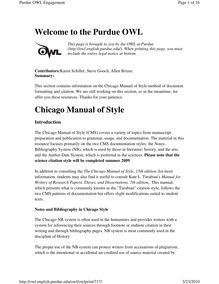
Summary: This section contains information on the Chicago Manual of Style method of document formatting and citation. These resources follow the 16th edition of the Chicago Manual of Style, which was issued in September Contributors:Jessica Clements, Elizabeth Angeli, Karen Schiller, S. C. Gooch, Laurie Pinkert, Allen Brizee Last Edited: 4/3/ · This section contains information on The Chicago Manual of Style method of document formatting and citation. These These resources follow the sixteenth edition of The Chicago Manual of Style, which was issued in September File Size: KB 2/11/ · A Brief Guide to Chicago Manual of Style Endnotes Endnotes demonstrate your familiarity with primary and secondary sources. They signal shifts between the authors’ opinions and engagement with sources. Precise notes are important to show readers when you switch from one source to another. Remember that footnotes simply prove your
Purdue OWL: Chicago Manual of Style 16th Edition
This page is brought to you by the OWL at Purdue University. When printing this page, you must include the entire legal notice. All rights reserved. This material may not be published, reproduced, broadcast, rewritten, or redistributed without permission. Use of this site constitutes acceptance of our terms and conditions of fair use. This section contains information on The Chicago Manual of Style CMOS method of document formatting and citation. These resources follow the seventeenth edition of The Chicago Manual of Style 17t h e ditionwhich was issued in Please note that although these resources reflect the most recent updates in the The Chicago Manual of Style 17 th edition concerning documentation practices, you can review a full list of updates concerning usage, technology, professional practice, etc.
at The Chicago Manual of Style Online. To see a side-by-side comparison of the three most widely used citation styles, including a chart of all CMOS citation guidelines, see the Citation Style Chart. The material on this page focuses primarily on one of the two CMOS documentation styles: the Notes-Bibliography System NBwhich is used by those working in literature, history, and the arts.
The other documentation style, the Author-Date System, is nearly identical in content but slightly different in form and is preferred by those working in the social sciences.
Though the two systems both convey all of the important information about each source, they differ not only in terms of the way they direct readers to these sources, but also in terms of their formatting e. For examples of how these citation styles work in research papers, consult our sample papers:. In addition to owl purdue chicago manual of style The Chicago Manual of Style 17th edition for more information, students may also find it useful to consult Kate L.
Turabian's Manual for Writers of Research Papers, Theses, and Dissertations 8th edition. This manual, which presents what is commonly known as the "Turabian" citation style, owl purdue chicago manual of style, follows the two CMOS patterns owl purdue chicago manual of style documentation but offers slight modifications suited to student texts.
The Chicago Notes and Bibliography NB system is often used in the humanities to provides writers with a system for referencing their sources through the use of footnotes, endnotes, and through the use of a bibliography.
This offers writers a flexible option for citation and provides an outlet for commenting on those sources, if needed. In addition, it can protect writers from accusations of plagiarism, which is the intentional or accidental uncredited use of source material created by others.
In the Notes and Bibliography system, you should include a note endnote or footnote each time you use a source, whether through a direct quote, paraphrase, or summary. Footnotes are added at the end of the page on which the source is referenced, while endnotes are compiled at the end of each chapter or at the end of the entire document. In either case, a superscript number corresponding to a note, along with the bibliographic information for that source, should be placed in the text following the end of the sentence or clause in which the source is referenced.
If a work includes a bibliography, which is typically preferred, then it is not necessary to provide full publication details in notes. If you cite the same source again, or if a bibliography is included in owl purdue chicago manual of style work, the note only needs to include the surname of the author, a shortened form of the title if more than four wordsand the page number s.
However, in a work that does not include a bibliography, it is recommended owl purdue chicago manual of style the full citation be repeated when it is first used in a new chapter.
In contrast to earlier editions of CMOS, if you cite the same source two or more times consecutively, CMOS recommends using shortened citations. In the NB system, the footnote or endnote itself begins with the appropriate full-sized number, followed by a period and then a space. In the NB system, the bibliography provides an alphabetical list of all sources used in a given work. This page, most often titled Bibliography, is usually placed at the end of the work preceding the index.
It should include all sources cited within the work and may sometimes include other relevant sources that were not cited but provide further reading. Although bibliographic entries for various sources may be formatted differently, all included sources books, owl purdue chicago manual of style, articles, websites, etc. If no author or editor is listed, the title or, as a last resort, a descriptive phrase may be used. Though useful, owl purdue chicago manual of style, a bibliography is not required in works that provide full bibliographic information in the notes, owl purdue chicago manual of style.
All entries in the bibliography will include the author or editor, compiler, translatortitle, and publication information. Titles of books and journals are italicized.
Titles of articles, chapters, poems, etc. are placed in quotation marks. For more information and specific examples, see the sections on Books and Periodicals.
Please note that this OWL resource provides basic information regarding the formatting of entries used in the bibliography. For more information about Selected Bibliographies, Annotated Bibliographies, and Bibliographic Essays, please consult Chapter Find Info For Find Info For Academics Admissions Current Students Athletics About Careers Prospective Students Research and Partnerships Quick Links Apply News President Shop Visit Give Emergency.
Purdue Online Writing Lab College of Liberal Arts. Writing Lab Purdue OWL Research Contact Site Map. Research and Citation Chicago Style CMOS Formatting and Style Guide. Welcome to the Owl purdue chicago manual of style OWL This page is brought to you by the OWL at Purdue University.
Chicago Manual of Style 17th Edition Summary: This section contains information on The Chicago Manual of Style CMOS method of document formatting and citation.
Chicago Manual of Style Part 1
, time: 5:57Chicago Manual of Style Footnotes

The Chicago Manual of Style - 17th Edition Notes & Bibliography Formatting and Style Guide. Brought to you by the Purdue Online Writing Lab. Chicago Style. formatting for notes and bibliography is often used in the humanities, especially in history, literature, and the arts 2/11/ · A Brief Guide to Chicago Manual of Style Endnotes Endnotes demonstrate your familiarity with primary and secondary sources. They signal shifts between the authors’ opinions and engagement with sources. Precise notes are important to show readers when you switch from one source to another. Remember that footnotes simply prove your Homepage to The Chicago Manual of Style Online. University of Chicago Find it. Write it. Cite it. The Chicago Manual of Style Online is the venerable, time-tested guide to style, usage, and grammar in an accessible online format. ¶ It is the indispensable reference for writers, editors, proofreaders, indexers, copywriters, designers, and publishers, informing the editorial canon with sound

No comments:
Post a Comment